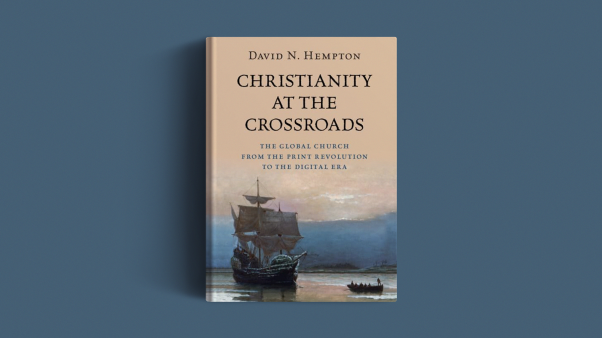Robert Webber once reminded evangelicals that “the road to the future runs through the past.” If evangelicalism is fracturing, we may just find our way to unity through what Kevin Vanhoozer called “Protestant catholicity” by retracing our steps. This, of course, raises the thorny question “What is an evangelical?” People have made valiant efforts to sort evangelicals into groups or types.
Evangelicals are a diverse bunch, and the rapid growth of the movement in the Global South has only increased this diversity. It needs to be said more often and more clearly that evangelicalism is not an American movement—it is a global one—and the vast majority of the world’s evangelicals today are African, Asian, and Latin American. Evangelicalism was a transnational movement from the very outset and has never been confined to a single nation or ethnicity.
David Bebbington, whose intellectual labors laid the cornerstone for building out a robust evangelical historiography, is a British evangelical whose perspectives have helpfully challenged American-centric descriptions of the movement. In this new era of world Christianity, deeper engagement with the global church (and the older church) could lead us closer to an evangelical catholicity.
Billy Graham’s life, shaped by encounters with the global church, offers an important precedent. One example is Graham’s friendship with John Stott, whom he met during his travels in Britain. In his autobiography Just as I Am, Graham wrote that Stott became “one of my best friends.” Stott, an evangelical and a Cambridge-educated Anglican, was influential in Graham’s journey toward a more ecumenical evangelicalism, one less marked by the fundamentalism Graham encountered as a student at Bob Jones College.
During the 1954 All-Scotland Crusade, Graham publicly announced he no longer considered himself a fundamentalist—a transformation that would have significant implications for American evangelicalism during the second half of the century. To reframe David Hollinger’s Protestants Abroad, we might say that Billy Graham set out to change the world and changed American evangelicalism instead.
David N. Hempton’s Christianity at the Crossroads: The Global Church from the Print Revolution to the Digital Era shows how encounters often take place at crossroads or networks and have significantly transformed global Christianity. His work, conceived for the prestigious Gifford Lectures, is a selective retelling of Christianity over the past five centuries. Hempton, a distinguished professor at Harvard Divinity School, blends narrative history with imaginative historiography. His methodology as a social historian shifts away from nations, denominations, and institutions and focuses instead on “transnational flows and networks.”
He frames his analysis through three interlocking concepts: nuclei (religious ideas), networks (the channels by which ideas travel), and nodes (the places where ideas are received and reshaped). He admits that preparing this work in the middle of the COVID-19 pandemic further animated his work about how ideas spread.
The book begins with print culture in the 16th century and closes with digital media in the 21st. Luther’s theological ideas—justification by faith and the freedom of the Christian—functioned as nuclei, with the printing press as the network spreading them. The print revolution transformed religion as Reformation ideas spread like “a religious virus” through sermons, treatises, Bibles, and hymns. Cities such as Wittenberg, Germany; Nuremberg, Germany; and Basel, Switzerland became key nodes of encounter and dissemination.
Hempton applies this framework to other events in Christian history: the Jesuits’ Spiritual Exercises as nuclei linking formation and mission, Our Lady of Guadalupe as a single image generating widespread devotion, and British evangelicals recruiting Black Loyalists to Sierra Leone through transatlantic networks.
He turns to Protestant internationalism—Pietism, evangelical missions, dispensationalism, fundamentalism, and Pentecostalism. Though marked by conflict, evangelicals constructed what he calls a “global fraternity.” He examines women’s networks in the 20th century, showing how the nuclei of feminism has worked in both egalitarian and patriarchal contexts. He concludes, “Women have found imaginative ways to create spheres of influence, and sometimes even to control, the religious traditions they inhabit.”
The final chapter on the digital revolution explores how technology has “re-imagined sacred space” and democratized the religious marketplace. Large ministries have harnessed digital technology most successfully, promoting the idea that “bigness” is a sign of blessing. A new group of specialists has emerged whose authority is based more on technical expertise than pastoral credentials. Case studies include the spread of the prosperity gospel, the global influence of Hillsong Worship, and the worldwide rise of digital platforms. But as Byung-Chul Han observes, digital technology produces “more communication but not more community.” The chapter on digital technology is chock-full of thought-provoking implications for the church.
Hempton’s mastery of secondary literature is impressive. At times it feels like reading a well-written annotated bibliography on major developments in Christian history from the Reformation to the present. His impressive engagement of hundreds of academic monographs is one of the most important contributions of this work.
He particularly notes the need for more research on the influence of money in the history of Christianity—how giving and spending have shaped expressions of faith. “Following the money” along networks can tell us a lot about the history of Christian movements. Historians such as Mark Noll and Larry Eskridge have touched on these issues in More Money, More Ministry: Money and Evangelicals in Recent North American History, and their work deserves a wider hearing, but Hempton underscores the need for additional research.
But not everyone will agree with his generalization that Christianity has had a “subversive alliance with imperial power” and has been guilty of “cultural rape.” While some academics sustain the Christianity-and-colonialism trope, Dana Robert and many others have challenged older models, showing that the issues are far more complex. Missionaries often “converted colonialism” for evangelistic purposes, criticized abuses, and made significant sacrifices for those they came to serve. Still, Hempton’s critique deserves to be heard. Christians have often failed to live up to the claims of the gospel, and the best apologetic is to confess, not defend, our sins.
Hempton delivered his lectures at the University of Edinburgh, itself a significant node where new ideas have emerged in the study of world Christianity. Scholars like Andrew Walls, Lamin Sanneh, Dana Robert, Brian Stanley, and Kirsteen Kim have shown that Christianity is both local and global, polycentric and interconnected. Walls especially noted how the gospel (nuclei) was carried by missionaries (networks) to new lands (nodes), where it flourished through Indigenous witness.
This transmission created something new without losing the essence of the old. To use a metaphor from dendrology (which Hempton mentions in chapter 1), when the old vine of the gospel is planted in new soils, it produces a new wine with distinctively local notes. Hempton’s framework offers a taxonomy that encourages historians to situate their research within these broader global developments and to show how nations, denominations, and institutes are connected to the whole.
He offers another key takeaway for evangelicals: Understanding the evangelical movement as a diverse “global fraternity” also provides a more hopeful way of thinking about the present and imagining the future. Christianity has always been a global movement. Even in its evangelical expressions, it has never been confined to one nation, denomination, or institution. The ancient church had centers in Jerusalem, Rome, Alexandria, Constantinople, Canterbury, and Seleucia-Ctesiphon. Evangelicalism itself began as a transatlantic movement within global Protestantism, which was itself rooted in what fourth-century Christians called the “one, holy, catholic and apostolic church.”
Global evangelicalism is part of a very old story, one that began before the 18th century. Evangelicals today can find wisdom and encouragement by remaining rooted in the long story that began before the foundation of the world. And just as we are part of an old story, we are connected to a big story, one that now includes a “global fraternity” of some 600 million evangelicals. Global evangelicals have not given up on the movement, nor are they abandoning the label.
As Brian C. Stiller recently noted in his contribution to Evangelicals: Who They Have Been, Are Now and Could Be, “A decision on what name best suits us globally is not a choice we can leave for Americans to decide.”
When I went to Kenya some 20 years ago to teach church history at the Nairobi Evangelical Graduate School of Theology, I suggested to my colleague Mark Shaw that I might include postmodernism in the curriculum. His clever response was that postmodern theory is an interesting “tribal concern,” more relevant to Western academia. Yes, there are tribal matters for us to consider—such as who American evangelicals voted for in the last presidential election. But these are tribal matters. Let us consider them but not lose sight that evangelicals are part of a global fraternity that John Stott simply called “gospel people and Bible people.”
F. Lionel Young III is a senior research associate at the Cambridge Centre for Christianity Worldwide. He is the author of World Christianity and the Unfinished Task: A Very Short Introduction.














